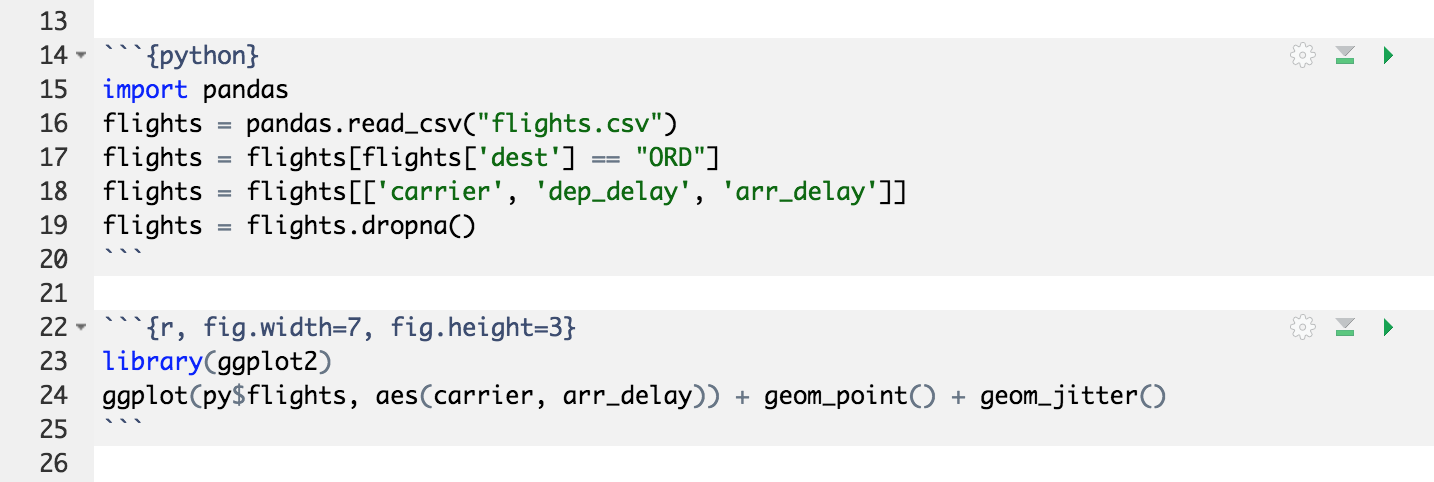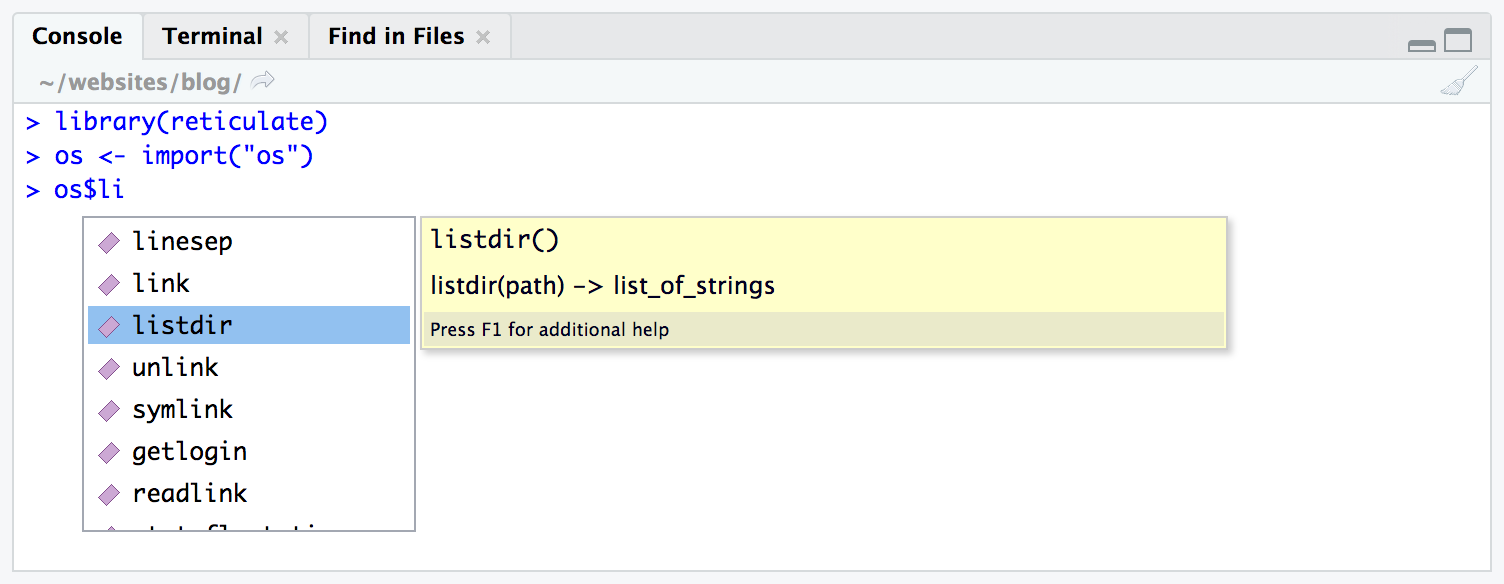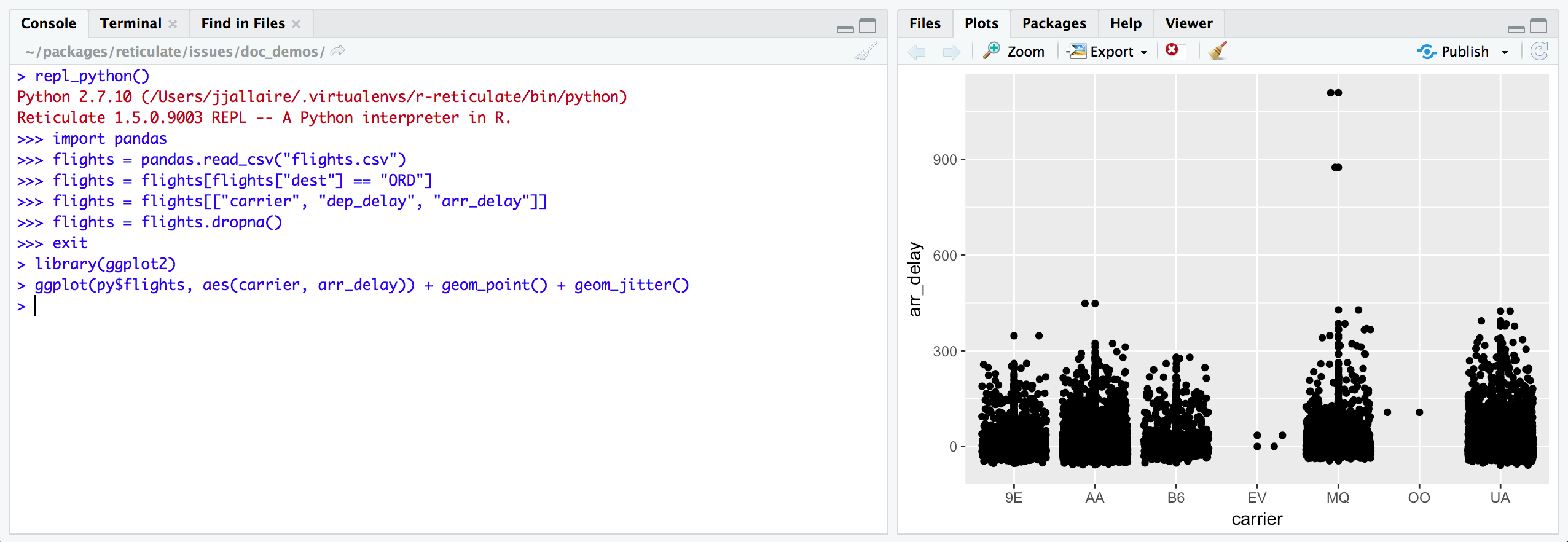loge -amazing project
The reticulate package provides a comprehensive set of tools for interoperability between Python and R. The package includes facilities for:
-
Calling Python from R in a variety of ways including R Markdown, sourcing Python scripts, importing Python modules, and using Python interactively within an R session.
-
Translation between R and Python objects (for example, between R and Pandas data frames, or between R matrices and NumPy arrays).
-
Flexible binding to different versions of Python including virtual environments and Conda environments.
Reticulate embeds a Python session within your R session, enabling seamless, high-performance interoperability. If you are an R developer that uses Python for some of your work or a member of data science team that uses both languages, reticulate can dramatically streamline your workflow!
Install the reticulate package from CRAN as follows:
install.packages("reticulate")By default, reticulate uses the version of Python found on your PATH
(i.e. Sys.which("python")).
The use_python() function enables you to specify an alternate version,
for example:
library(reticulate)
use_python("/usr/local/bin/python")The use_virtualenv() and use_condaenv() functions enable you to
specify versions of Python in virtual or Conda environments, for
example:
library(reticulate)
use_virtualenv("myenv")See the article on Python Version Configuration for additional details.
You can install any required Python packages using standard shell tools
like pip and conda. Alternately, reticulate includes a set of
functions for managing and installing packages within virtualenvs and
Conda environments. See the article on Installing Python
Packages
for additional details.
There are a variety of ways to integrate Python code into your R projects:
-
Python in R Markdown — A new Python language engine for R Markdown that supports bi-directional communication between R and Python (R chunks can access Python objects and vice-versa).
-
Importing Python modules — The
import()function enables you to import any Python module and call it’s functions directly from R. -
Sourcing Python scripts — The
source_python()function enables you to source a Python script the same way you wouldsource()an R script (Python functions and objects defined within the script become directly available to the R session). -
Python REPL — The
repl_python()function creates an interactive Python console within R. Objects you create within Python are available to your R session (and vice-versa).
Each of these techniques is explained in more detail below.
The reticulate package includes a Python engine for R Markdown with the following features:
-
Run Python chunks in a single Python session embedded within your R session (shared variables/state between Python chunks)
-
Printing of Python output, including graphical output from matplotlib.
-
Access to objects created within Python chunks from R using the
pyobject (e.g.py$xwould access anxvariable created within Python from R). -
Access to objects created within R chunks from Python using the
robject (e.g.r.xwould access toxvariable created within R from Python)
Built in conversion for many Python object types is provided, including NumPy arrays and Pandas data frames. For example, you can use Pandas to read and manipulate data then easily plot the Pandas data frame using ggplot2:
Note that the reticulate Python engine is enabled by default within R Markdown whenever reticulate is installed.
See the R Markdown Python Engine documentation for additional details.
You can use the import() function to import any Python module and call
it from R. For example, this code imports the Python os module and
calls the listdir() function:
library(reticulate)
os <- import("os")
os$listdir(".") [1] ".git" ".gitignore" ".Rbuildignore" ".RData"
[5] ".Rhistory" ".Rproj.user" ".travis.yml" "appveyor.yml"
[9] "DESCRIPTION" "docs" "external" "index.html"
[13] "index.Rmd" "inst" "issues" "LICENSE"
[17] "man" "NAMESPACE" "NEWS.md" "pkgdown"
[21] "R" "README.md" "reticulate.Rproj" "src"
[25] "tests" "vignettes"
Functions and other data within Python modules and classes can be
accessed via the $ operator (analogous to the way you would interact
with an R list, environment, or reference class).
Imported Python modules support code completion and inline help:
See Calling Python from R for additional details on interacting with Python objects from within R.
You can source any Python script just as you would source an R script
using the source_python() function. For example, if you had the
following Python script flights.py:
import pandas
def read_flights(file):
flights = pandas.read_csv(file)
flights = flights[flights['dest'] == "ORD"]
flights = flights[['carrier', 'dep_delay', 'arr_delay']]
flights = flights.dropna()
return flightsThen you can source the script and call the read_flights() function as
follows:
source_python("flights.py")
flights <- read_flights("flights.csv")
library(ggplot2)
ggplot(flights, aes(carrier, arr_delay)) + geom_point() + geom_jitter()See the source_python() documentation for additional details on
sourcing Python code.
If you want to work with Python interactively you can call the
repl_python() function, which provides a Python REPL embedded within
your R session. Objects created within the Python REPL can be accessed
from R using the py object exported from reticulate. For example:
Enter exit within the Python REPL to return to the R prompt.
Note that Python code can also access objects from within the R session
using the r object (e.g. r.flights). See the repl_python()
documentation for additional details on using the embedded Python REPL.
When calling into Python, R data types are automatically converted to their equivalent Python types. When values are returned from Python to R they are converted back to R types. Types are converted as follows:
| R | Python | Examples |
|---|---|---|
| Single-element vector | Scalar | 1, 1L, TRUE, "foo" |
| Multi-element vector | List | c(1.0, 2.0, 3.0), c(1L, 2L, 3L) |
| List of multiple types | Tuple | list(1L, TRUE, "foo") |
| Named list | Dict | list(a = 1L, b = 2.0), dict(x = x_data) |
| Matrix/Array | NumPy ndarray | matrix(c(1,2,3,4), nrow = 2, ncol = 2) |
| Data Frame | Pandas DataFrame | data.frame(x = c(1,2,3), y = c("a", "b", "c")) |
| Function | Python function | function(x) x + 1 |
| NULL, TRUE, FALSE | None, True, False | NULL, TRUE, FALSE |
If a Python object of a custom class is returned then an R reference to that object is returned. You can call methods and access properties of the object just as if it was an instance of an R reference class.
The following articles cover the various aspects of using reticulate:
-
Calling Python from R — Describes the various ways to access Python objects from R as well as functions available for more advanced interactions and conversion behavior.
-
R Markdown Python Engine — Provides details on using Python chunks within R Markdown documents, including how call Python code from R chunks and vice-versa.
-
Python Version Configuration — Describes facilities for determining which version of Python is used by reticulate within an R session.
-
Installing Python Packages — Documentation on installing Python packages from PyPI or Conda, and managing package installations using virtualenvs and Conda environments.
-
Using reticulate in an R Package — Guidelines and best practices for using reticulate in an R package.
-
Arrays in R and Python — Advanced discussion of the differences between arrays in R and Python and the implications for conversion and interoperability.
From the Wikipedia article on the reticulated python:
The reticulated python is a species of python found in Southeast Asia. They are the world’s longest snakes and longest reptiles…The specific name, reticulatus, is Latin meaning “net-like”, or reticulated, and is a reference to the complex colour pattern.
From the Merriam-Webster definition of reticulate:
1: resembling a net or network; especially : having veins, fibers, or lines crossing a reticulate leaf. 2: being or involving evolutionary change dependent on genetic recombination involving diverse interbreeding populations.
The package enables you to reticulate Python code into R, creating a new breed of project that weaves together the two languages.



